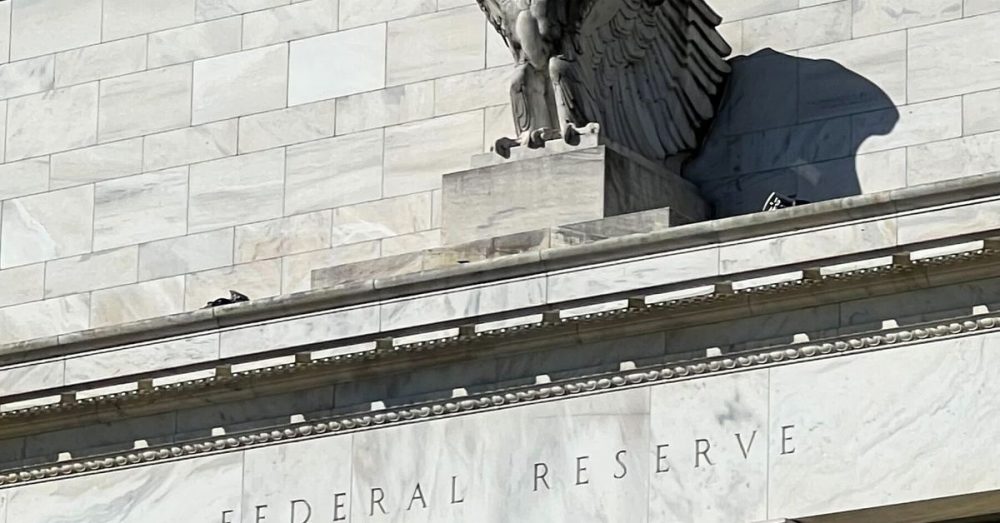Crypto can’t become what many of its proponents want it to be without banks, but U.S. regulators are circling the wagons around the banking system they oversee. That barrier is only getting wider as the Federal Reserve and other agencies turn away crypto firms trying to link with the traditional financial system.
Several recent regulatory actions – including the Federal Reserve Board’s (FRB) January decision to reject crypto-focused Custodia Bank’s application for membership – indicate federal regulators are coordinating on policy that aims to ring-fence crypto from the broader U.S. banking system, experts say.
The FRB’s rejection of Custodia’s membership application came hours after the White House put out a statement urging Congress to “step up its efforts” to regulate the crypto industry and, when crafting new legislation, avoid “greenlighting mainstream institutions…to dive headlong into cryptocurrency markets,” which the statement warned would be a “grave mistake” that “deepens ties between cryptocurrencies and the broader financial system.”
Shortly after Custodia’s membership application was denied, the Federal Reserve Bank of Kansas City dealt another blow to the crypto bank, denying its long-pending application for a master account.
Less than two weeks after Custodia’s double-whammy rejections and the White House’s warning against crypto contagion, fresh rumors about more crypto banking crackdowns have begun to circulate.
On Wednesday, Fortune reported that the Office of the Comptroller of the Currency – the independent wing of the Treasury Department that oversees the national banking industry – was rumored to be primed to reject two crypto companies’ applications for a national trust bank charter.
Paxos and Protego both received conditional approval to convert into a nationally chartered trust bank in early 2021, but the final status of their applications has hung in the balance longer than the allowed 18-month deadline.
Both institutions told Fortune the rumors were untrue, and a source with knowledge at Paxos also confirmed with CoinDesk that Paxos had not been asked by the OCC to withdraw its application, nor had the application been denied. But over the weekend, Paxos announced it would stop offering the Binance USD stablecoin at the direction of the New York Department of Financial Services.
Crypto lobbyists and industry leaders spent years trying to sell the benefits and credibility of digital assets and blockchain technology to U.S. lawmakers and regulators. Then 2022 rolled around.
“A lot of that is out the window, and it’s very frustrating,” said Georgia Quinn, general counsel for Anchorage Digital, who has been cringing over the U.S. regulators’ latest maneuvers. “I’m very disheartened by all of the recent statements and positions.”
Still, she said she hopes crypto-focused banking can find its place.
“I want more regulated institutions, not less,” she said. “You don’t address risks by pretending they don’t exist.”
To achieve a future with widespread, mainstream usage of crypto’s innovations, the industry needs to tie up to regulated U.S. banking. That’s how people will come off the sidelines and adopt digital tokens, virtual properties and smart contracts as part of their daily financial lives, when their trusted financial institutions can interact directly with all the new products.
But 2022 is a poisoned pill that may knock digital assets down for a long time. A general response from U.S. regulators to step back from 2022’s mayhem of gigantic hacks, bad ideas, laundered money, manipulated prices and gross fraud is beginning to harden into policy.
Inertia is a powerful thing in Washington. Once momentum builds in one direction, it tends to continue. Stopping it and reversing it can take a massive exertion.
Mick Mulvaney, a former acting White House chief of staff under former President Donald Trump, has been watching how the federal government is stiffening its crypto resistance after FTX. But he thinks the position isn’t calcifying just yet and that the most important response could eventually come from the lawmakers on Capitol Hill, where he used to be a congressman.
“I don’t think it’s cast in stone,” Mulvaney, who now advises Swiss crypto startup Astra Protocol, said in an interview. “There’s a vibrant debate on the Hill right now.”
Whether the administration’s momentum will be checked by eventual legislation that makes allowances for crypto innovations, he said, “My gut is that Congress will win.”
So far, however, regulators have had the first say.
Coordination
“Agencies have been pretty open about the fact that they are coordinating and working together on crypto and digital assets issues,” said Grant Butler, a Boston-based partner at law firm K&L Gates.
“There’s a lot of caution and skepticism on the part of banking regulators around cryptocurrency and the exposure to that in the financial system,” Butler added.
Regulators, Butler said, want to avoid crypto-focused banks with different charters or different primary regulators, which makes it more difficult to consistently track them and spot potential issues.
“Banking regulators have long been skeptical of allowing non-traditional activities into the banking system because doing so introduces risk and that risk, ultimately, is borne by the public when things go south,” Chris Odinet, a professor of commercial law at the University of Iowa College of Law, told CoinDesk.
And that risk, as Joseph Lynack, a Washington, D.C.-based partner at Dorsey & Whitney, pointed out, can be enormous.
“Considering that the crypto industry lost approximately $2 trillion in a few months last year, the federal agencies are correct in adopting a go-slow approach – or at least, it is understandable,” Lynack said. “Can you imagine what would happen to the banking system if banks lost a similar amount of capital in as short a period of time?”
A shifting stance
The White House and regulators have come together on crypto in a way rarely seen outside of a financial crisis. President Joe Biden started it with an executive order issued last March. After that, the Treasury Department and banking agencies mostly headed in the same direction.
The high-profile collapse of FTX lent new energy, and some rethinking of the government stance. On Jan. 3, the Fed, OCC and Federal Deposit Insurance Corp. (FDIC) put out a joint statement cautioning banks about the risks of working with crypto companies. On Jan 27, the White House warned against the possibility of crypto contagion and egged on the regulators.
That same day, the Fed announced a new policy that effectively insisted that any firms seeking access to the Fed system (think: Custodia) has to face the same crypto constraints as any other banks – including a formal sign-off from their federal regulator any time they want to engage in activity with digital assets. That policy went into effect on Feb. 7.
Banks that have been closely allied with the crypto sector have begun distancing themselves as their U.S. watchdogs made it clear they’d see crypto as a danger. Moonstone Bank, where Sam Bankman-Fried’s trading firm Alameda Research had an ownership stake, said it’s retreating from crypto and returning to its old community-bank identity. And Signature Bank said it’s limiting crypto-tied deposits, representing about a quarter of its business.
“I think the Biden administration was not super enthusiastic about private crypto before [FTX],” said Julie Hill, a professor of banking and commercial law at the University of Alabama School of Law. “But I think that the FTX collapse has made them even more concerned.”
Stablecoins
In addition to the concerns raised by FTX’s implosion last November, Hill suggested that part of the Federal Reserve’s decision to reject Custodia’s membership application could be tied to its plans to issue a stablecoin. Paxos, one of the companies rumored to be facing its own rejection by the OCC, also has its own stablecoin.
When the U.S. regulators first weighed in on stablecoins, they argued that future policy should insist that issuers either be banks or be regulated like them. They’ve changed that tune and now suggest that issuing stablecoins could risk an institution’s safety and soundness.
“It seems that [the FRB is] very concerned about the Custodia plan to issue a stablecoin. It seemed like that was part of the motivation behind their decision to not allow them to be a member,” Hill said. “I think that other crypto-first companies that hope to issue stablecoins should be nervous.”
Butler, however, doesn’t see much truth in theories that Custodia’s rejection was due to fears that its stablecoin would compete with a future central bank digital currency (CBDC).
“I don’t think that’s what this is,” Butler said. “I don’t think regulators are comfortable with [stablecoins] or with the banks that wish to issue them – there is a degree of discomfort there,” But I don’t think [the rejection] is driven by competition with a central bank digital coin. I think there is a broader risk concern.”
Operation Choke Point 2.0?
Several figures in the crypto industry, including investor Nic Carter, have made compelling comparisons between the current crackdown on crypto banking and Operation Choke Point.
Choke Point was a secretive initiative at the Department of Justice (DOJ) during Barack Obama’s presidency. Federal officials improperly pressured banks to close the accounts of legal businesses like gun and ammunition dealers and payday lenders.
Though regulators denied the program’s existence for years, documents and depositions made public in 2018 revealed the extent of the operation’s reach.
Though Butler said he could see why people would draw comparisons, he doesn’t think the current crypto banking crackdown is quite as bad as Choke Point.
“Obviously a couple people have gotten into trouble, but [regulators] aren’t saying, ‘Hey, you can’t bank these clients; they’re verboten,” Butler said. “They’re definitely trying to ring fence it…but I think there’s a little bit of a difference, and a different sort of underpinning to the actions than there was in the Operation Choke Point situation.”
Wall Street wins
Banking experts told CoinDesk they don’t see regulators attempting to cut crypto out of the banking system entirely – instead, they think that regulators are trying to drive crypto towards established banking institutions that are already heavily regulated.
“Banks are going to be able to offer traditional custody services and safekeeping services. Granted, they’re going to have to meet a very, very high bar on the safety and soundness around that [but] using a bank to custody [crypto] doesn’t seem foreclosed,” Butler said.
However, Butler expects the ability to use a bank charter as an on-ramp from fiat to digital currencies will be curtailed until there’s more regulatory clarity.
“I think [the current crackdown] is probably going to impact the ability to get banking services but I think there are going to be people out there to service the industry,” Butler said. “As far as doing it through a bank or being a novel bank that does this – no, I think it’s going to be pushed out of the banking sector.”
What next?
While getting pushed out of the banking industry isn’t exactly a death knell for crypto, it could present a significant impediment to crypto moving into the mainstream.
“The regulators’ stiff-arming is a problem for crypto because being tied to banks would add legitimacy to crypto in the minds of ordinary Americans,” said Ian Katz, a banking policy expert at Capital Alpha.
“Perhaps if the crypto world stabilizes, over time regulators will become more willing to let crypto into the heavily regulated banks,” Katz added. “But for now it looks like regulators want to put a wall between crypto and banks. And that will probably contribute to the feeling among many consumers that crypto is too risky or niche for them to get involved with.”







